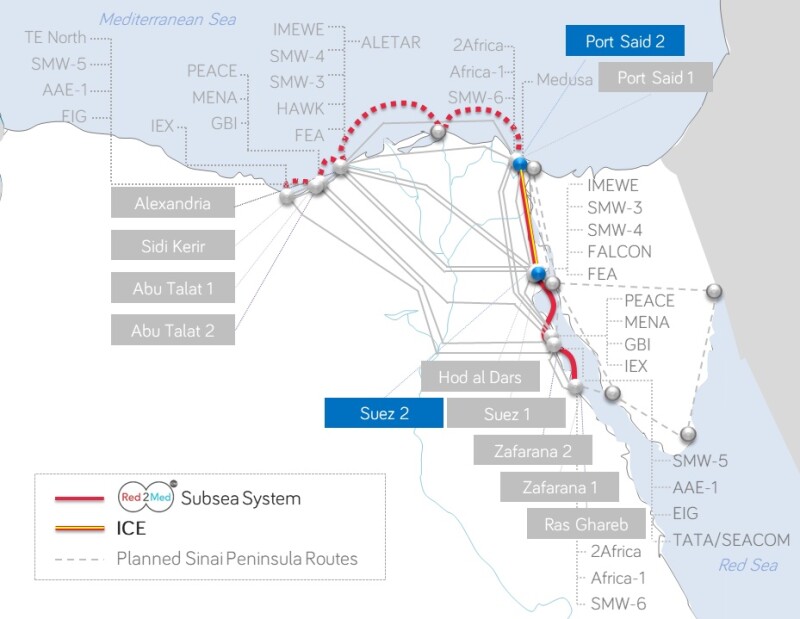
Telecom Egypt has continued with its laser-guided focus on maximising its home market's position as a key global hub for cables. Managing director and CEO Adel Hamed outlines how the company's recent activities with cables like Red2Med and 2Africa are boosting both international and domestic communications.
What will the Red2Med cable recently launched by Telecom Egypt mean for the international telecommunications market?
The Red2Med cable will help make communications between East and West even richer, adding a very short, resilient and seamless route to complement the multiple other networks that already mark out Egypt as a crucial player in data infrastructure. Launched last October, the crossing subsea cable, fully owned by Telecom Egypt, serves to enhance the country’s position as a key international hub for global communications networks that connect Africa, Asia and Europe.
The cable runs from a landing station in Ras Ghareb by the Gulf of Suez in the Red Sea to another in Port Said by the Mediterranean. The two landing points will connect over hybrid links comprised of three segments – firstly, the Red Sea subsea festoon cable linking Ras Ghareb, Zafarana and Suez, whose landings were completed in October 2022; secondly, the Internet Corridor of Egypt [ICE], which is in its final stages of development; and thirdly, the planned Mediterranean subsea festoon cable.
Indeed, over 90% of data making the journey between East and West passes through Egypt, highlighting how crucial the country is to global communications. The opening of the Red2Med cable for business therefore boosts the nation’s position as a gateway for traffic that offers a safe, secure and reliable passage between continents.
How does the cable fit into Telecom Egypt’s overall strategy?
Red2Med reinforces Telecom Egypt’s strategy to expand its infrastructure from an international route into an eminent regional digital hub. It also builds on the company’s efforts to steadily expand its subsea and terrestrial cable infrastructure since the 19th century, when it was a hub for telegraph lines serving Egypt, the wider region and beyond.

Telecom Egypt has always focused on making the most of its home country’s unique and strategically important geographic location, investing extensively in the past decade to roll out and bolster landing stations and terrestrial routes. On top of that, the company has invested in becoming a member of international alliances that own submarine cables running via Egypt.
This continued investment means that Telecom Egypt connects as many as 12 subsea cable systems from the East to 14 from the West today, while a range of other projects are in the pipeline.
And the company is not stopping there, but instead intends to keep on following this ethos by further expanding its international reach. With that in mind, it aims to grow its portfolio to at least 16 landing stations, 14 diversified crossing routes and 18 subsea cable systems in the next couple of years.
You mentioned ICE as part of the link connecting Red2Med. Can you tell us more about it?
The Internet Corridor of Egypt is the new ‘golden’ terrestrial crossing route connecting the Mediterranean and the Red Sea. The 200km, one-of-a-kind fibre-optic crossing route connects the new Suez 2 and Port Said 2 landing stations through the Al Morshedeen Road on the west bank of the highly secure Suez Canal campus.

On a global level, ICE is by far the fastest, shortest and most reliable link connecting submarine cables between the Red Sea and Mediterranean. The trans-Egypt crossing offers subsea cable owners a state-of-the-art route characterised by a new level of resiliency and diversity.
What else has Telecom Egypt been doing recently in terms of landing cables and what do these moves mean for the market?
Telecom Egypt recently inaugurated the first Egypt landing of the 2Africa subsea cable in Ras Ghareb on the Red Sea, the same location where the Red2Med festoon landed just a few weeks earlier. The company is providing hybrid crossing options for the cable, comprising the subsea route via Red2Med and two diverse terrestrial routes east of the Suez Canal.
The 45,000-kilometre 2Africa cable, which is being deployed to Africa, Europe and Asia, will be the longest subsea network deployed to date, ultimately bringing seamless connectivity to over a third of the global population.
Reaching such a large proportion of the population means the cable is set to have a major impact on improving people’s lives by providing a boost to essential services in sectors from education to healthcare and business, and aiding the overall digital transition.
These developments highlight additional ways in which the company is playing a key part in connecting the world from its critical strategic location in Egypt, paving the way to meet continued global demand for bandwidth far into the future. They are also geared towards bridging the digital divide, reducing the gap between those who do and don’t have access to reliable internet.
What other cable-related activity has Telecom Egypt been carrying out?
Last December, the company signed an agreement with Greece’s Grid Telecom to deploy a subsea cable between Egypt and Greece. The deal will bring major synergies for both parties and represents a successful outcome from 10 months of negotiations, after the two struck a deal to jointly explore fibre-based connectivity options early last year.
The route, which is set to link up Port Said to the island of Crete, will be the shortest Mediterranean pathway between Egypt and Europe, providing an ideal low-latency option and a new entry point to Europe. The system will also extend northwards into the Balkans and key surrounding destinations in Central and Western Europe, as well as southwards to the Arabian Peninsula and other areas in Africa and Asia.
This deal and Telecom Egypt’s other recent cable initiatives come after the company announced early last year that it would extend its reach as part of the consortium for the SEA-ME-WE 6 submarine cable. Once completed, the cable will be almost 20,000 kilometres long and will link up multiple countries between Singapore in the East and France in the West via Egypt’s network.
Furthermore, Telecom Egypt struck a deal with global subsea player Aqua Comms last summer to supply crossing and landing facilities for the new EMIC-1 cable, which runs between East Africa, Asia and Europe. And on a regional basis, Telecom Egypt is improving connectivity to neighbouring countries like Sudan, Libya and Jordan.
How do Telecom Egypt’s various infrastructure rollouts contribute to both the international and domestic market?
Deploying such an extensive architecture means that international partners and customers have robust and reliable access to communications, while it further boosts Egypt’s own infrastructure and internet speeds.
With its numerous different projects, Telecom Egypt is improving diversity and resilience on high-density traffic routes between regions, while helping partners to rapidly scale, meet their communications needs across continents and slash the cost of network ownership.
In addition, the various rollouts and other moves fit in with Egypt’s own push towards digital transformation as part of its Vision 2030 strategy. Nations worldwide have recognised making such transitions as even more urgent in the wake of the Covid-19 pandemic, which has shown the importance of staying connected in times of emergency and with many people transitioning to working more from home.
On another note, Telecom Egypt is keen on further refinement of the regulatory and permit environment for the international community. In that regard, in early 2022 the company introduced licence landing rights [LLR], which eliminates crossing fees applied by the NTRA [National Telecommunications Regulatory Authority], following an improvement round of fees in 2018. Like its predecessors, this model will be subject to future enhancements based on market dynamics that will make it more convenient for the company’s partners.
Additionally, the cycle for permits has also improved immensely. The company’s clients are now well-aware of its duration, which enables them to make informed decisions about their cable systems.
How do you see the current overall market situation for Telecom Egypt, and how are things looking for the company in 2023 and beyond?
We’ve continued to go from strength to strength with our cable projects over the past year, with initiatives like Red2Med, 2Africa and the project with Grid Telecom in Greece contributing to the richness of cables running through Egypt and beyond. This has aided both the domestic and much wider international telecoms market.
All these activities and the results they have had set us up well for this year and beyond, with Telecom Egypt’s continued buildout and landing of networks helping to significantly bolster overall international telecommunications infrastructure.
With demand for bandwidth growing across regions worldwide, alongside our ability to serve those needs and close the digital divide, we see a huge opportunity to keep taking communications to the next level in the coming years.




